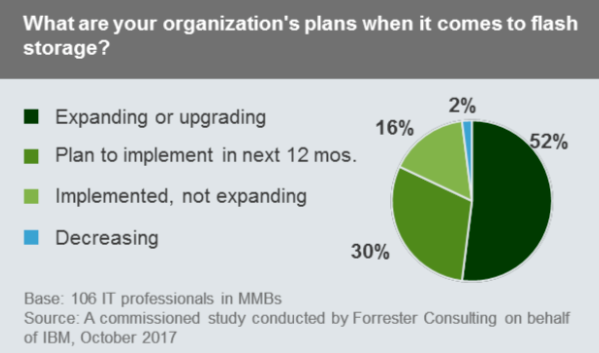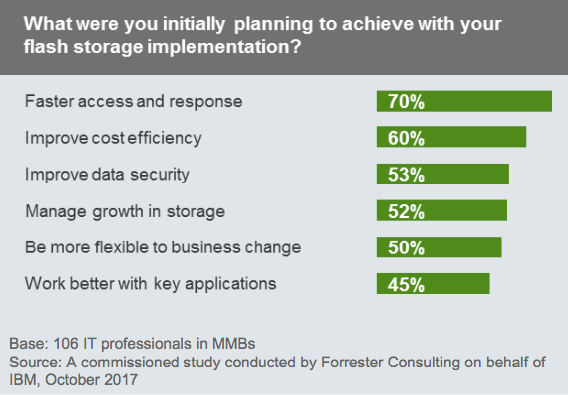IBM Flash: The mid-market advantage
A recent market survey conducted by Forrester Consulting and commissioned by IBM confirms that flash storage is a big hit among mid-market businesses (MMB). In fact, 82 percent of MMB IT decision-makers are either planning to deploy flash-based data storage or are already upgrading their flash solutions.[1]
The Forrester survey provided a valuable snapshot of what MMBs are currently doing with flash: 
- Mid-market organizations are actively adopting flash storage as a part of their storage strategy.
- A majority of respondents expect to continue their investments, with almost half aspiring to an all-flash storage environment.
What benefits does flash offer mid-market companies? Forrester notes: “IT professionals in this survey are clearly balancing technical performance and business efficiency with their flash storage initiatives. As their world becomes more complex with cloud, data growth, and more complex applications, they are looking to flash to help drive speed, flexibility, and efficiency.”
Most of the survey respondents felt that flash performed well in major technical and business focus areas such as virtualization, security, cloud and flexibility, with flash performance contributing to improvements in key operational and business goals like responsiveness, managing changes in the business, and interacting better with key applications.
Mid-market businesses (MMB), defined in this survey as companies with 500 to 999 employees, are often viewed as being more sensitive to budget and risk constraints – because they are smaller, their IT budgets are often proportionately smaller and they have less ability to absorb failures. This means that MMBs are especially focused on cost-efficient, proven technology solutions. They can’t afford less.
IBM all-flash storage solutions offer exactly what MMBs indicate they are looking for – excellent performance, the flexibility to tailor solutions to almost any storage requirement, and a broad spectrum of choices to match MMB budget constraints and cost-efficiency objectives.
 Storwize is the family within the IBM Storage portfolio engineered to meet the needs of mid-market enterprises. IBM Storwize family combines industry-leading IBM Spectrum Virtualize technology and affordability in one mature product family with thousands of successful deployments worldwide.
Storwize is the family within the IBM Storage portfolio engineered to meet the needs of mid-market enterprises. IBM Storwize family combines industry-leading IBM Spectrum Virtualize technology and affordability in one mature product family with thousands of successful deployments worldwide.
Storwize family members are flexible storage solutions that enable organizations of all types and sizes with mid-range application workloads to efficiently and affordably meet the challenges of rapid data growth and constrained IT budgets. IBM Storwize V5030F is the entry level-priced all-flash solution. It leverages the cost advantages of high-density flash drives for low deployment costs and features an enhanced, intuitive user interface, synchronous/asynchronous replication, 600+ Storwize APIs, thin provisioning and snapshots, and flash-optimized data compression. Storwize V5030F also provides enterprise-grade system availability and data security, including non-disruptive data migration and remote mirroring using IBM HyperSwap technology. The arrays also provide “five-nines” availability, data-at-rest encryption, and a new distributed RAID technology that can reduce drive rebuild times up to 10 times over current RAID solutions.
The Forrester survey confirms that MMBs are seeing a profitable return on their flash investments and reaping the benefits of speed, flexibility and efficiency in their quickly evolving storage environments. For mid-market leaders that want affordable all-flash storage that provides Fortune 500-level functionality, IBM solutions such as Storwize V5030F offers unbeatable choices.
Discover how Storwize all-flash solutions can give your MMB the speed, flexibility, and cost-efficiency you need to capture and keep competitive advantage. Read more here.

